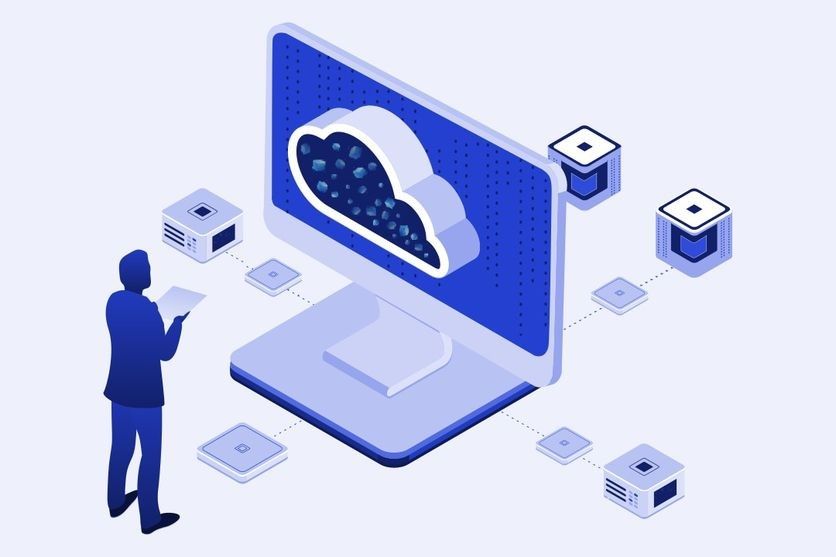It wasn’t so long ago that you needed to jump through burning hoops to set up and maintain any kind of IT infrastructure.
This lengthy process often involved the following steps:
- Buy a whole bunch of computers and local servers
- Install operating systems
- Set up and manage software licenses for each individual computer
- Repeat ad infinitum any time you want to scale up!
Believe me when I say that managing the above steps is tough. I’ve been setting up IT infrastructure for over a decade, and the old ways are definitely a huge time and cost sinkhole.
Today, though, cloud technology and infrastructure have matured into a skilful beast. It has thus become not only viable but even preferred to host your software needs on the cloud.
The first step towards this lofty future in the clouds is known as cloud migration. It’s a big undertaking that needs lots of preparation, but it could change the way you do business forever.
In this article, we’ll go through everything you need to know before starting the process for your company, including:
- What is cloud migration?
- The different types of cloud migration
- The benefits of cloud migration
- The challenges of cloud migration
What is cloud migration?
Cloud migration is the process of moving your company’s digital operations and content, such as data, software, and workflow, from on-premises equipment to cloud infrastructure. Your own IT team can carry out the migration, or your cloud provider’s team can assist in the process.

What are the main challenges of migrating to the cloud?
Cloud migration isn’t a magic bullet that fixes all your platform problems in a jiffy. Instead, it comes with its own implementation challenges that you need to know before you begin.
Cost
Moving to the cloud incurs various direct and direct costs, such as:
- Training staff in the new applications or practices
- Increased bandwidth requirements
- Cost of migration
- Service disruption
On the other hand, cloud migration can save a lot of money for your company in the long run! However, you’ll need to take this initial investment into consideration before you proceed.
Executive buy-in
Having your senior management on board with cloud migration is essential to success. Their opinion and support of the process will define how quickly and smoothly cloud adoption occurs throughout your company.
Securing executive buy-in is a big challenge, as with any risky endeavour. You need to show that cloud migration is worth the investment, and you need to do this for each executive in ways that are tailored to their priorities.
Skills shortage
The move to the cloud requires a unique understanding of the cloud, its security and compliance requirements and awareness of how each cloud provider or platform fares for various use cases. It’s not enough to have standard IT experts accustomed to managing local networks and applications.
Unfortunately, there’s a skills shortage when it comes to cloud expertise. As a result, it may be difficult to acquire talent who can help you migrate to the cloud smoothly. One way to alleviate this is to hire a cloud migration company that’ll guide you through every step of cloud migration rather than hiring in-house cloud experts. We at Flying Donkey are experts in cloud migration and have helped dozens of companies manage every aspect of the process from start to finish.
What are the best practices for enterprise cloud migration?
Cloud migration is a huge step for your business. Following these best practices can make things easier and improve the benefits you get out of it.

1. Come in with a strategy
You can’t just get up one day and suddenly move everything to the cloud! So it’s important to come in with a plan to ease your team into the changeover. You don’t want to risk service disruption if something goes wrong or your team isn’t trained effectively in the new system.
One good practice is to migrate to the cloud in phases. You can start with migrating the workflows that are easiest to train and migrate before anything else. For example, you can start with CRM, migrating data and operations from your current on-premises services to a cloud-based platform.
2. Consider your existing network infrastructure
The cloud is reliant on an Internet connection. Therefore, you want to ensure that your existing Internet connection will be able to handle the load. Upgrade to a business-class ISP if you haven’t already, or select a plan with greater bandwidth.
In addition, after cloud migration, your team will be accessing your cloud services and data using the public Internet. This can create some concerns for potential downtime or security. To do this, you can leverage various solutions offered by top providers. After AWS migration, for example, you can take advantage of AWS Direct Connect, which offers a private, dedicated connection between Amazon Web Services and your company.
3. Design a cloud governance framework
Moving to the cloud comes with a whole host of security and compliance concerns. These may be very different from what you’re used to with on-premises applications.
As you move to the cloud, you need to set up a framework that defines the roles, policies, and regular audits to keep your business compliant with the latest standards. This procedure can’t be delayed; it has to be in place before you switch to the cloud so that you’re following best practices from day one.
What are the types of cloud migration?
Before starting the migration process, you need to know what you want to accomplish through cloud migration. Perhaps you want to make your IT operations more scalable or improve the collaboration between international divisions. Maybe you just want to simply reduce the costs of maintenance and license acquisition.

Your primary goals will define the method of cloud migration that you use. There are 6 cloud migration strategies, known collectively as the 6 “R’s”, each with unique challenges and benefits.
Rehosting
Rehosting, or “lift-and-shift,” is the quick and easy way of migrating to the cloud. Basically, you take whatever applications you were using and put them on your cloud host.
Rehosting is a speedy way to deploy to the cloud. However, the applications that you’re currently using might not be taking advantage of the cloud framework. They might not be as scalable as a dedicated cloud application, for instance.
Replatforming
With re-platforming, you keep your existing applications just like with rehosting. However, the difference is that you optimize their code to take advantage of the cloud before you migrate. Of course, this involves a little more work, but it ensures that you still get to keep the original software.
Refactoring
In refactoring, you rework all of your old software with cloud-optimized code. This method allows you to truly unleash the benefits of the cloud, such as flexibility and scalability. Of course, it does have some upfront costs to contend with, but in the long term, you will reap all the benefits of lower ongoing costs and more business agility but using the full cloud offering.
Repurchasing
If you don’t want to bother with refactoring your existing applications’ code, you can also repurchase new licenses for applications or services that are explicitly designed for the cloud. You will need to invest in training and API integrations and modifying your workflow to accommodate the new applications.
Retiring
After going through cloud migration, you might find that some of your existing applications may no longer be useful. Retiring them is a valid choice to reduce license upkeep costs. Just make sure that you won’t need any of these retired applications for legacy purposes!
Revisiting
Some parts of your business or workflow may not be ready for the cloud, so you can choose to skip them for now. Then, later on, you can revisit cloud migration for those areas.
Benefits of migrating to the cloud
Cloud migration is a difficult and highly involved process. However, a wide variety of benefits await companies who go through it successfully.

Here are some advantages which the companies we’ve helped migrate to the cloud have experienced:
Lower costs
Switching to a cloud provider means that you move a lot of your IT maintenance costs to them. This can save you a lot of money! In most cases, you’ll also be reducing your risk of service downtime, given the general stability and reliability of cloud infrastructure.
Scalability
Before the cloud, scaling up your business’s digital capabilities meant spending IT man-hours on buying new machines, setting up software licenses, and other tedious and time-consuming tasks. But after moving to the cloud, scaling can be done with the click of a button or even automatically, depending on your provider.
Adding new users is also very easy. Just run them through a user access control panel and have them log in through a browser interface. This also makes it easier to implement a BYOB policy, as compatibility is mostly resolved when everything is happening through the Web.
Constantly updated software
One of the biggest pains for IT was ensuring that all software on all users’ machines is updated and compatible.
With the cloud, your provider ensures that everything is up to date. In fact, this process might actually be fully transparent in many cases, and you won’t notice any downtime while your services update in the background. Aside from that, compatibility will be very high because of the platform-agnostic approach of Web-based apps.
Cloud migration: The best time is now
Cloud migration is no longer a futuristic process reserved for companies on the bleeding edge of tech. Instead, it’s become an essential part of any business’s digital strategy and can help you save costs and scale more efficiently than ever.
Of course, you want to do it right the first time. That’s why it’s best to leave it to the experts. At Flying Donkey, we provide complete cloud migration services that help you move your servers and sites to the cloud with minimal downtime and full testing in place. We also monitor your needs and help you adjust your cloud specifications based on your usage characteristics and requirements.
Contact us now for a consultation!






An excellent blog post. I appreciate your sharing this informative article. It has been helpful and insightful to me.
You are most welcome! Happy to be of help! 🙂